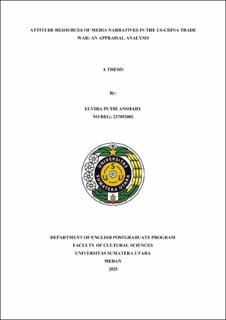Attitude Resources of Media Narratives in The Us-China Trade War: An Appraisal Analysis
Sumber Daya Sikap Narasi Media dalam Perang Dagang AS-Tiongkok: Analisis Penilaian

Date
2025Author
Anshary, Elvira Putri
Advisor(s)
Sinar, T Silvana
Zein, T Thyrhaya
Metadata
Show full item recordAbstract
The US–China trade war is not only an economic conflict but also a discursive arena where media outlets construct competing ideological narratives. This study examines how evaluative language is used to shape such narratives in editorial coverage by The New York Times (TNYT) and South China Morning Post (SCMP). Framed within Appraisal Theory (Martin and White, 2005), particularly the Attitude subsystem (Affect, Judgment, and Appreciation), and using Fairclough’s (1995) model of Critical Discourse Analysis (CDA), the study explores how language encodes ideological positions and why different evaluative strategies are employed. The data consists of 20 editorials, 10 from each outlet, published between January and March 2025. These texts were annotated using the UAM Corpus Tool, identifying 1,084 instances of Attitude. In the first stage, these instances were classified into types of Attitude to examine how evaluative language represented the trade war. The findings show that both outlets relied heavily on Appreciation but differed ideologically. TNYT used Appreciation in 70.4% of the cases, primarily to negatively assess China’s economic policies. Judgment accounted for 28.3%, often criticizing China’s leadership and trade behavior. Affect was minimal (0.3%), suggesting a formal editorial tone. SCMP showed higher use of Appreciation (88.1%), mostly to present China as cooperative and responsible. Judgment occurred in 11.6%, highlighting China’s constructive role. Affect remained limited (0.3%) but occasionally conveyed alignment with values such as stability and global responsibility. In the second stage, the analysis examined how these resources built contrasting portrayals. TNYT combined negative Appreciation and Judgment to frame China as a threat, reinforcing U.S. national interests. SCMP employed positive Appreciation and Judgment to legitimize China’s leadership and depict U.S. actions as protectionist. In the final stage, CDA’s explanation dimension was used to explore the rationale behind these choices. The results indicate that each outlet’s evaluative stance is shaped by its institutional ideology, editorial orientation, and geopolitical context. TNYT’s discourse reflects alignment with Western liberal democratic values, while SCMP’s stance reflects China’s global positioning and national interests. These findings illustrate how evaluative language functions as a tool to reinforce ideological perspectives and influence public understanding of international conflict.
Collections
- Master Theses [255]
